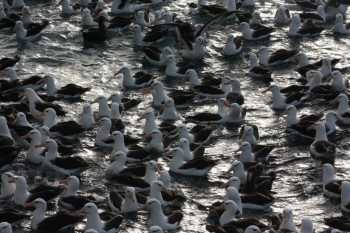Rebecca Lewison (Department of Biology, San Diego State University, California, USA) and colleagues identify taxa-specific hotspots for fisheries bycatch of seabirds, marine mammals and turtles in the Proceedings of the National Academy of Sciences of the United States of America (PNAS). “This analysis provides an unprecedented global assessment of the distribution and magnitude of air-breathing megafauna bycatch, highlighting its cumulative nature and the urgent need to build on existing mitigation successes.”
The paper’s abstract follows:
“Recent research on ocean health has found large predator abundance to be a key element of ocean condition. Fisheries can impact large predator abundance directly through targeted capture and indirectly through incidental capture of nontarget species or bycatch. However, measures of the global nature of bycatch are lacking for air-breathing megafauna. We fill this knowledge gap and present a synoptic global assessment of the distribution and intensity of bycatch of seabirds, marine mammals, and sea turtles based on empirical data from the three most commonly used types of fishing gears worldwide. We identify taxa-specific hotspots of bycatch intensity and find evidence of cumulative impacts across fishing fleets and gears. This global map of bycatch illustrates where data are particularly scarce—in coastal and small-scale fisheries and ocean regions that support developed industrial fisheries and millions of small-scale fishers—and identifies fishing areas where, given the evidence of cumulative hotspots across gear and taxa, traditional species or gear-specific bycatch management and mitigation efforts may be necessary but not sufficient. Given the global distribution of bycatch and the mitigation success achieved by some fleets, the reduction of air-breathing megafauna bycatch is both an urgent and achievable conservation priority.”

Black-browed Albatrosses gather behind a trawler in the South Atlantic
Photograph by Graham Parker
Reference:
Lewison, R.L., Crowder, L.B., Wallace, B.P., Moore, J.E., Cox, T., Zydelis, R., McDonald, S., Di Matteo, A., Dunn, D.C., Kot, C.Y., Bjorkland, R., Kelez, S., Soykan, C., Stewart, K.R., Sims, M., Boustany, A., Read, A.J., Halpin, P., Nichols, W.J. & Safina, C. 2014. Global patterns of marine mammal, seabird, and sea turtle bycatch reveal taxa-specific and cumulative megafauna hotspots. Proceedings of the National Academy of Sciences of the United States of America. doi/10.1073/pnas.1318960111.
John Cooper, ACAP Information Officer, 14 April 2014

 English
English  Français
Français  Español
Español